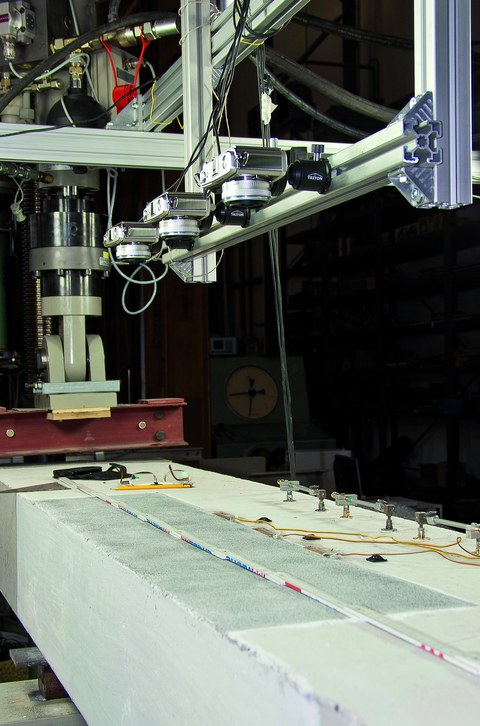2D photogrammetry for the recording of cracks
Table of contents
Project data
| Titel | Title 2D-Photogrammetrie zur messtechnischen Erfassung der Rissentstehung und Rissbreitenentwicklung | 2D photogrammetry for the recording of cracks Förderer | Funding Im Rahmen des Projektes: Kennwertermittlung von Textilbeton bei Anwendung an wasserundurchlässigen Betonkonstruktionen gefördert durch die Arbeitsgemeinschaft industrieller Forschungsvereinigungen “Otto von Guericke“ e. V. (AiF) Zeitraum | Period 03.2010 – 10.2011 Leiter | Project Manager Dr.-Ing. Harald Michler Bearbeiter | Contributor Dr.-Ing. Harald Michler |
Report in the yearbook 2011
2D Photogrammetry for the Recording of Cracks

Test setup with photogrammetrie
For the task of examining the influence of a textile carbon reinforcement to the tightness of reinforced concrete components the choice was given to the method of the photogrammetry. A special 2D photogrammetry system was designed to observe continuously the crack initiation and the development of the crack widths at 4 point bending tests on concrete specimen. Normally two cameras are used for the observation of a point to be able to grasp the position of the point exactly by means of triangulation in the room. This 2D photogrammetry system will observe the points with only one camera, which results in some restrictions, but it will not influence the data mainly. The lost information about the distance of the points to the camera and with that the scale can be observed separately. However, this can be easily included afterwards to calculate the cracking data.
It could be problematic, if the distance between the camera and the object changes and/or the object is turned, i.e. the object level is no longer parallel to the focal plane, because the results are then distorted (at it). It can be stated that this leads, under the given conditions of admission (distances resolution picture and object size), only to acceptable faults in the precision. The measurements of the photogrammetry could be corrected even correspondingly, if the deformations of the specimen are known selectively, e.g. from IWA data.
As camera, every standard digital camera is suitable, preferably one with a bigger chip (APS-C) and changeable objectives. Also manual setting possibilities for focus, exposure and synchronization, e.g. over the cable trigger, are of advantage. Depending on the measurement task the possible maximum modulating frequency or the duration working frequency can also be the decisive criterion for the camera choice. The visual legitimacies also should be taken into account in the choice of focal length and object distance and with that the picture distance.
If these recommendations are considered, a great cost advantage can be obtained in comparison with the usual two camera systems and/or the observation of a bigger area becomes affordable with several cameras (panorama).
The evaluation of the pixel pictures then takes place with standard software. The won point movings are available for every evaluation. It could be shown that with this method meaningful measurements can be won with relatively simple aids.
